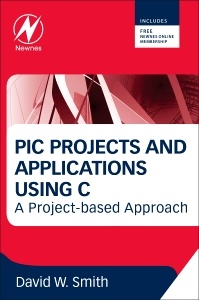Description
PIC Projects and Applications using C
A Project-based Approach
Author: Smith David W
Language: English
Subject for PIC Projects and Applications using C:
204 p. · 15x22.8 cm · Paperback
Description
/li>Contents
/li>Readership
/li>Biography
/li>Comment
/li>
PIC Projects and Applications Using C details how to program the PIC microcontroller in the C language. The book takes a learn-by-doing approach, with applications covering topics such as inputs, outputs, keypads, alphanumeric displays, analogue-to-digital conversion, radio transmitters and receivers, data EEPROM, interrupts and timing. To aid debugging, the book provides a section detailing the use of the simulator and in-circuit debugger.
With this book you will learn:
- How to program the PIC microcontroller in C
- Techniques for using the simulator and debuggers to find faults on your code
- The ins and outs of interfacing circuits, such as radio modules and liquid crystal displays
- How to use the PIC on-board functions, such as interrupts and timing modules, and make analogue measurements
Chapter 1. Introduction to the Microcontroller and C Chapter 2. First C Program Chapter3. Using 8 outputs Chapter4. Inputs Chapter 5. Keypad Scanning Chapter 6. Analogue to Digital Conversion Chapter 7. Alpha Numeric Displays Chapter 8. Porting Code to other Microcontrollers Chapter 9. Timers/Counter Modules Chapter 10. Interrupts Chapter 11. Fault Finding, using the Simulator and the In Circuit Debugger Chapter 12. Radio Transmitters and Receivers Chapter 13. EEPROM Data Memory Chapter 14. Projects Chapter15. C extra Appendix A. Data Sheets Appendix B. Useful Contacts Index
Electronics engineers, including embedded systems designers and control engineers, technicians in industry, hobbyists needing a more complete grounding in microcontroller principles and applications. Students taking introductory level classes in courses in electronics / microelectronics.
- Relevant parts of the language are introduced and explained when required for those new to the subject
- Core principles are introduced gradually for self-paced learning
- Explains how and why a software program works, and how to alter and expand the code

